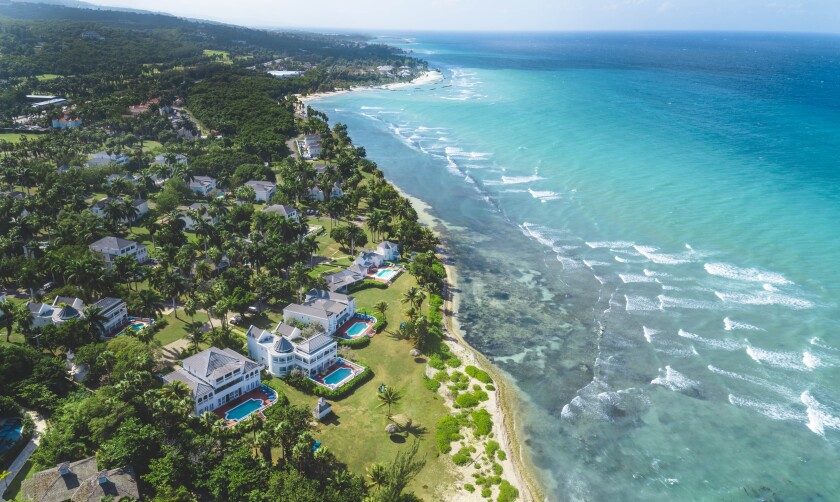
Guy Steuart III carries the mantle of storyteller, curator and chairman all rolled into one. There's no other choice, really, because the ghosts of the past have no voice. For whatever reason, it comes naturally to Half Moon Resort's chairman, and he does it with aplomb.
The affable Steuart — as articulate as a scholar and of lineage linked to the resort's emergence — took on an unenviable task of restoring much of the fabled 400-acre Jamaican oceanfront property these past six years.
"There were a lot of arrows pointed at us for trying to reimagine a high-end aspirational, elegant beach resort," says Steuart from his Chevy Chase, Maryland, office. "That's our footprint. That's our DNA."
To understand the DNA, think of it like a complete woven tapestry. Except for each rogue strand of fabric, in a strange way, every subtle tug leads toward the core, revealing something that indelibly makes up the body of work's entirety.
The resort, under consideration as a landmark and the highest-rated property in Jamaica by Forbes, began operations in 1954 on rugged, underdeveloped sugar cane fields. It didn't hurt that the yawning, kaleidoscopic Caribbean Sea served as an inviting backdrop, as picturesque as it was breathtaking. Monet couldn't have had a better canvas on which to paint.
Besides the exquisite natural beauty, over the years the resort has grown to include various amenities that touch on equestrian activities, water sports, a 68,000 square-foot spa oasis, a children's village, tennis courts and a manicured championship 18-hole layout designed by Robert Trent Jones Sr. It is a vacationer's playland, catering to the anonymous and personage of high importance.
"We like to say Half Moon is a destination within a destination," says Shernette Crichton, Half Moon’s first-ever female general manager. "It's also about creating memories."
Jamaica serves as the third-largest Caribbean island, best known for its Rastafarian movement, Bob Marley and Dennis Brown's reggae influence, and gaining its independence from the UK in 1962. Of course, there is much more to the island as it has grown as a tourist destination.
Dating back to its origins, Half Moon's early stages weren't exactly archetypical. Steuart understands this better than anyone. The resort's lore lies within its past. And with time's passage, history runs afoul of wading into an abyss filled with infinite sepia-toned memories and fading cultural aspects, first paling into a haze before being abjectly erased by invisibleness.
That's precisely the channel Steuart, made chairman in 2014, is trying to navigate.
"We're in the memory-making business, but we are bridging divides," says Steuart, who spends 7-10 days a month at the resort. "We're about creating stories and those stories unequivocally involve our past."
As curator, Steuart has a vested interest because of family ties. How Half Moon came to be can be attributed to industrial spirit and patience.
The resort's DNA stretches back 60-plus years when a group of 17 American, British and Bermudian entrepreneurs purchased 35 acres of land on a bay in 1954 that was once the loading dock for Rose Hall's sugar shipments, which ran along Jamaica's idyllic North Coast.

The beach fronted the breathtaking crescent bay, used for stevedoring. Steuart's grandparents, Curtis and Esther Steuart, became investors after they first visited Jamaica in the early 1950s.
Since 1904, Curtis Steuart had a keen eye for business. He had been involved in real estate, coal and ice that gave way to petroleum, and automobiles.
Guy Steuart III says when he asked his grandfather how he got involved in the Jamaica property, he learned his grandparents were at a cocktail party at the Sunset Lodge before being introduced to Harold deLisser, who was looking for investors in a new resort-type endeavor.
The 17 families who ultimately came on board were movers and shakers of the era. Radio City Music Hall designer Donald Deskey; Firestone Tire and Rubber company's Harvey Firestone Jr.; Richard Reynolds of the Reynolds Metal Company and local Reynolds Jamaica; and Laurence Armour of U.S. meat packaging giant Armour Packing Company.
All of that certitude. All of that business savviness. Oh, the acumen. Except, in this case, it was like developing an electric car but taking it to a gas station to recharge.
"None of them knew how to run a resort," says Steuart, who is also the senior vice president for Steuart Investment Company (SIC), which serves Washington, D.C. metropolitan markets in commercial real estate development. "All the families looked at it more like a collection of cottages, and wouldn't it be nice if someone looked over them while we're not there?"
At the time, they had opened Half Moon Hotel and Cottage Colony with 17 whitewashed cottages and 30 beachfront rooms.
Curtis Steuart, meanwhile, sat back and quietly watched it unfold. It turned out to be a prescient move. He believed for the resort to be successful, the cottages needed to be part of the property pool, instead of other investors' beliefs that their cottage would "be mothballed until you came back," adds Steuart.
Over time, Curtis Steuart bought the majority out. With each move, Curtis Steuart's influence strengthened, while also changing the board's composition. Today, only three of the original family investors remain. Soon that collection of cottages became hotel rooms and a resort.

The property developed quite a cachet, so much so that it attracted celebrities, royalty, politicians and socialites. Queen Elizabeth II, Prince Phillip and Prince Charles, Monaco's Prince Rainier and Princess Caroline, as well as John F. Kennedy and Jacqueline Kennedy vacationed there.
In fact, the Kennedys spent a month at the resort prior to his U.S. presidential inauguration.
"Half Moon is world famous. It's a serious property," says Keith Stein, Rose Hall Development’s director of golf operations, who manages the nearby Cinnamon Hill and White Witch courses.
Culturally speaking, Half Moon stepped into the spotlight when the blind singing pianist Lance Hayward and his jazz quartet, the house band, recorded an eponymous album "At The Half Moon Hotel" on Chris Blackwell's famous Island Records. It's a slice of pop culture that came full circle with the late Hayward's son, Stuart Hayward, who gave Steuart 10 copies of the hard-to-find album circa 2016.
Also about that time, Steuart and the board realized the property had gradually gone from a gleaming, pristine 1955 Ford Thunderbird to one in need of reinvention. The board decided to infuse money. It made sense with tourism as the island's No. 1 industry and the fact that Sangster International Airport was a mere 10 minutes away.
"We had been doing a lot of things old school," Steuart says. "I've been an agent of change. We had invested $85 million plus or minus, without interest carry, into the resort. Over six years we master planned it for the first time in 60 years."
The board agreed that it needed to elevate its standards, or seize upon the Jamaican hospitality that has always been a bedrock of property operations. The addition of Eclipse at Half Moon, designed by the Hart Howerton firm, involved 57 new luxurious rooms and suites, a massive infinity pool, as well as two restaurants and numerous new amenities that embrace Jamaica's history, naturalness and culture.
It joined the resort's existing Founders Cove and Rose Hall Villas, located at the opposite ends of the property.
As Eclipse neared completion, the board brought on the highly-regarded Salamander Collection to manage Half Moon.
"The opening of Eclipse has reestablished Half Moon as one of the finest resorts in the Caribbean, and our goal is always to continue to elevate its status and service" said Sheila Johnson, Founder and CEO of the Salamander Collection.
If anything could be said positively of the COVID-19 pandemic it would be that the brief shutdown allowed the new construction to mature, says Steuart. Just after a soft launch celebration around Valentine's Day in 2020, COVID-19 hit and the country’s borders closed leading to staff furloughs.
Steuart visited the property in late September that year, calling it an eerie experience. No one was on the grounds except for a couple of landscapers. Steuart stopped them as they went about their work, asking them how they were.
"They said they felt blessed," Steuart says. "I go, 'How so? It's a terrible time.' They said, 'We know you haven't been making money, business isn't there, but you hired us back and you didn't have to do that.'"
It dawned on Steuart how much a family business touches society, extending through generations. It's made him steadfast in protecting the culture while serving as an archivist.
"The analogy I make when we were building this new central area, what we call Eclipse, is at one end you look south and see this steadfast, resolute and largely unspoiled green hills behind you, beckoning what is behind that? The country. It's a beautiful, beautiful land.
"Meanwhile, out of the front door looking north is this mysticism and ever-changing dynamism of the colors of the water, and here we are in this nexus between these two worlds. It's sort of the metaphor for what we do as a hotel. We're in the memory-making business, creating stories."

